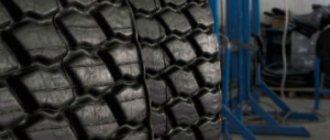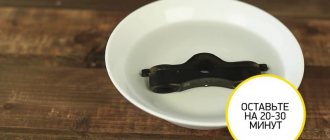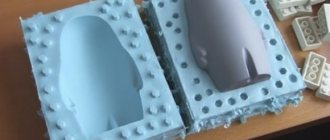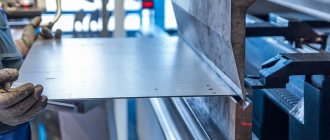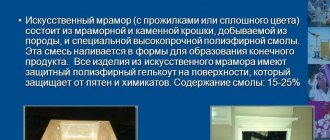Since I always deal with the arrangement of the local area on my own without the involvement of specialists and expensive materials, I decided to puzzle myself with the question of how to make crumb rubber at home. In the future I will need it for landscape design. I offer two options for manufacturing raw materials: simple and complex.
Source dorogaya-zemlya.ru
We make crumb rubber with our own hands using a homemade crusher
Every year, thousands of tires are lost in landfills and landfills, despite the fact that for an enterprising person they are a free resource from which crumb rubber can be produced.
If you need it only once, you can buy it in the required quantity from the manufacturers.
But where can you get crumb rubber if you need it on an ongoing basis and in large quantities?
It is worth considering purchasing your own tire recycling equipment.
However, not everyone can afford a full-fledged installation , and not everyone will find such an investment profitable. The solution is to create equipment with your own hands and use it to produce crumb rubber from tires at home.
Making your own rubber coating
A troubling thought often haunts the heads of savvy craftsmen: “Is it possible to make a safety coating from crumb rubber yourself?” Yes, let's look at interesting Internet offers together. The first interesting question: “How to make crumb rubber at home?” Let's start with the fact that there are really original tips on the Internet for making crumb rubber:
“At the initial stage, it is necessary to prepare a sufficient amount of raw materials, i.e. old car inner tubes and corresponding cutting tools. To make a coating with an area of one square meter and a thickness of 10 mm, about 8 kg of crumb rubber is needed. When producing crumbs from old chambers, the loss of material by weight is minimal. Thus, it is necessary to prepare the starting material at the rate of 8 kg of old cameras per 1 square meter of coating. To grind rubber, you can use ordinary scissors or an ax. If desired, you can build special guillotine shears. As a last resort, you can organize cutting of the cameras with a fairly sharp knife. Making crumbs should be done according to the following algorithm:
- Remove all metal elements from the old camera
- Cut the camera into thin strips
- Grind the thin strips obtained in step 2"
Factory tire recycling
Hot press for making rubber tiles
It is clear that only the most purposeful will survive such a test, and only as an experiment. Having obtained crumb rubber in one way or another, we proceed to the manufacture of a safety coating.
It is impossible to make rubber tiles at home, since special equipment is required and the entire production technology must be followed. All that remains is a seamless coating. Here we should remember the restrictions on the use of seamless coating, which we previously discussed here. Next, we will consider a specific case of using expensive EPDM crumb rubber at home, taken from the Internet.
“So the object is a country house, a concrete platform in front of the garage of 8 m2. Photo "before", with the necessary materials and tools. True, a metal spatula, specially purchased, turned out to be unnecessary; a plastic one was used.
I bought a dark beige crumb. With a thickness of 10 mm of crumbs you need 7-8 kg per 1 square meter. m., the consumption depends on the evenness of the base and the hands of the paver, it took us 8. There is also a black secondary crumb, it is made from old tires, it costs 10 times less and, in principle, would also be suitable for covering the front of a garage, but the beige color is ideal approached the tiles on the terrace near the house, so we chose it. Add 15% of the binder to the crumbs, proportion 1*7, and mix with a drill. It's better to have a scale handy to weigh the parts, we added the binder with a jar, and it flows like honey, so it was very inconvenient.
Before applying the mixture, the base must be primed with a solution of 50% binder 50% solvent. The solvent is ordinary white spirit. We primed it in parts so as not to run on the glue. Then they simply poured the mixture with a trowel, leveled it and leveled it with a plastic spatula. It was periodically sprinkled with a bucket to prevent the glue from sticking.The mixture is very convenient and manageable to work with, and is flexible for about 30 minutes after application, so all imperfections can be corrected in time.
It turned out very similar to cork coating. It dried, however, longer than expected, almost a day.
Checking the car's coverage, demonstration run.
It turned out there was a trail of sand. Access to the yard is from a dirt road. But on beige crumbs it is almost invisible. Now I have my doubts about the black color on the ramp. The beige turned out to be very not easily soiled.Karcher can withstand it, the same nozzle as for the car is not brought closer than 20 cm, and sand and dirt are washed off from a regular garden hose.
You can use fine crumbs, then the surface will be smoother. But one of the advantages of the coating is that the dirt will remain on the coating and will not fall into the house or garage; it can then be washed off with water from a hose, and if there is no canopy, then the rain will wash it away. By the way, dry garbage, leaves, and grass can be easily swept away with a broom.
If you regularly turn the wheels on the surface, I think it won’t last long, again the question is which car, if the SUV is 2 t+ and the tires are studded, then the pavement will get damaged quickly.
Quote:
Message from Offroad TS, since the winter has finally passed (without incidents - I already read)? How was the snow/ice removed, how does the surface feel on a car track? If possible, with a photo
I give you a photo.
It seems like the snow has never been cleared away this winter. When turning the wheels in place, individual granules are torn out from the coating, but this is not critical, wear is not visible, and particles that were not initially incorporated are torn out. To be honest, this section is not heavily used, so there are definitely no ruts. There are no problems with cleaning, the sloping open area is washed off by rain. Which, considering entering the yard from the ground, is very good. And the sand is not particularly visible on the beige; the coating has not yet been cleaned after winter.
In this example, a seamless coating was laid at the entrance to the garage. The coating work was carried out by an enthusiast who had experience working with crumbs. The basis was taken from one of the expensive EPDM rubber crumbs. It should be noted that such crumb rubber is not sold in stores, and manufacturers do not sell it in small quantities. For this installation process, it is very important to thoroughly mix the chips and binder, and this is difficult to achieve under these conditions. The coating was not strong enough for its purpose. The rubber coating will be used under heavy load. Therefore, there is a fear that it will soon become unusable. In any case, such an experiment is an expensive pleasure. This means that before starting work, everything must be taken into account and weighed - literally and figuratively.
Another example of “home” work is decorating the porch with rubber crumbs. This work can also be done independently. We also attach an online report from the same craftsman:
This weekend I started making a porch at my dacha. I did it myself, so I didn’t get a detailed photo report, but the overall result is visible. And so traditionally there is a “before” photo, the remarkable configuration of the porch is a consequence of repeated reconstructions of the veranda. For the coating I chose two colors of crumb rubber. I decided to make the design simple - a dark frame with a bright middle, and decided to make the middle part a mix of 20% dark, 80% bright. Marking with chalk using a 10mm OSB ruler, which later became the rule. The total area of the porch is 5.5 sq.m., the frame took about three hours, it was necessary to sculpt the beautiful transitions and especially the vertical parts of the steps very carefully. But I did the whole middle in about 40 minutes. I didn’t use a stick this time so that the crumbs don’t stick to the spatula; you can lubricate it with a 50/50 solution of glue, binder and solvent. But I didn’t guess with the spatula, I bought a new one 40 cm, it turned out to be too big for a small frame. As a result, the corners turned out a little uneven, and I couldn’t stretch them properly. Here's a view of the almost finished porch. I left one corner for a passage, I'll finish it next weekend. "Semi-final" photo. Overall it looks good. A neighbor saw and thought that we had laid a rug on the porch. I'll make it beautiful and post a photo of it in finished form.
In principle, everyone can try to “conjure” a small fragment of rubber crumbs. However, as we have already said, you cannot buy such a volume of raw materials, dyes and polymer binders in a store.
BUT, now the ELITPLIT company is holding a promotion! If you have a great desire to work with an innovative material yourself, we will give you the opportunity to visit our production of rubber plates, and to get acquainted with the new rubber material for safety coatings, you can purchase at the ELITPLIT factory the necessary necessary set of components for experiments in the independent production of rubber coatings from yourself on the site. To visit the plant, you must contact the company's managers in advance by calling the ELITPLIT hotline . In addition, professional technologists will advise you on how to properly work with crumb rubber.
See also:
Rubber tile. GOST or TU? New certificates for rubber tiles Technical regulations for playgrounds EAEU TR 042/2017 Polyurethane adhesive for crumb rubber Trauma-proof coating. Question - answer Advantages of rubber tile coating Rubber tiles and curbs - safety coating Polymer drainage module 300x300x11 mm Rubber tiles or seamless coating? How to check the quality? Winter and summer in one color or reliable dyes for rubber tiles Hot or cold pressing of rubber tiles. Objective reality.
Recycling small amounts of rubber at home
If you need very little raw material, you can do without equipment at all.
All you need to do this is scissors and a cutter .
The metal cord is first removed from the tire, then divided into strips and crushed into smaller fractions to the required size .
At this point the process is considered complete.
The material for decorating paths, flower beds or a separate playground is ready for use.
But in order to obtain a larger volume of raw materials or to have income from processing tires at home, you need the appropriate equipment.
Tire recycling as a business
Availability of raw materials and equipment are favorable conditions for the business of recycling used tires. Discarded rubber is a valuable raw material. The costs will pay off in 6 to 12 months. Large motor transport enterprises will be willing to cooperate in the delivery of used tires.
To organize a business, several conditions must be met:
- Rent a room. At this stage, difficulties may arise because the premises must meet certain requirements. It is worth taking a closer look at the empty workshops of industrial enterprises.
- Think over a business plan with calculations of investments and payback, so as not to get unpleasant “surprises” in the future.
- Registration of LLC or individual entrepreneur.
- Purchase of necessary equipment and treatment plants.
- Hiring staff.
- Concluding agreements for the supply of raw materials and delivery of crumbs.
The ability to persuade and organize work will create conditions for business prosperity.
Requirements for production premises and warehouses
Before you start work, you need to resolve the issue with the premises. The area of the rented building must be at least 450-500 m2. The ceiling height is from 5 meters.
The room must be heated so that the temperature does not drop below +6˚C. To connect equipment to the building, power sources with a capacity of 300 kW are required. Recycling old tires produces a lot of dust, so you need to provide a ventilation system.
Production must have warehouses for raw materials. The first is where worn-out tires are stored, the second is for finished products. You should also make room for storing metal cord.
Reference. From 700 kg of raw materials, up to 50 kg of metal is obtained.
Staff
The successful development of a mini-plant for processing car tires largely depends on the staff. For continuous work in production, you will need 2 shifts of 2 people, an accountant to maintain documentation and financial flow.
2 more people for supplying raw materials and marketing the finished product. In order to save money at the initial stage, you can do this part of the work yourself.
Other expenses
Creating your own business from scratch will require certain investments. These include renting premises, purchasing equipment, tools, and workwear. Payment for electricity and rental of vehicles for transportation.
License for reception, processing and disposal
Used car tires are a high-hazard waste.
Important! To give a business legal status, it is necessary to obtain a license.
You need to collect a package of documents. Immediately think about what types of waste the production will process. If you miss one of the types, you will have to start the registration all over again.
Obtaining a license depends on the final act of the state environmental commission and sanitary doctors. In order not to make a mistake during registration, it is better to entrust the support of documents to a competent lawyer. Recycling tires requires skill, so employees must be certified to handle waste.
Failure to obtain a license may result in heavy fines and confiscation of equipment. Given its high cost, production cannot begin without proper registration.
Profitability calculations
An approximate estimate of expenses and income will build a clear line for the development of the waste tire recycling business.
Table No. 2 Initial investments
| expenditures | Quantity | Prices |
| Equipment | — | 1,000,000 – 1,500,000 rub. |
| Fuel tanks | 5-6 pcs. | 120,000 rub. |
| Tools, workwear, warehouse equipment | for 6-7 people | 160,000 rub. |
| Total | — | ≈ 1,780,000 rub. |
Table No. 3 Monthly expenses
| Payment for electricity | monthly | 15,000 rub. |
| Staff salaries | 15,000 rubles each. per person | ≈ 90,000 rub. |
| Rent and other expenses | monthly | ≈ 50,000 rub. |
| Raw materials | of necessity | free or cheap |
| Total | — | ≈ 155,000 rub. |
Table No. 4 Income
| Manufactured product | Quantity | Prices |
| Fuel | for 1 ton | 3,000-5,000 rub. |
| Metal | for 1 ton | 3000-6000 rub. |
| Carbon | for 1 ton | 3000-4000 rub. |
| Total | Depending on the amount of processed raw materials | ≈ 400,000-500,000 rub. |
Approximate income can be calculated taking into account the amount of waste disposed. If you subtract monthly expenses, the initial investment will pay off within 8-12 months from the start of production.
Construction of a tire crusher
There are three main methods for producing crumbs:
- Crushing tires after cooling them with liquid nitrogen to –190 degrees.
- Production of crumbs using full-cycle industrial equipment with cord removal and subsequent rubber grinding.
- Processing using universal crushers, which can be done at home yourself.
The first two methods require large investments. The third option is available to everyone
who has the opportunity and desire to make a crusher at home.
The necessary units can be made independently in a workshop or at a production site - where there are metal-cutting machines (lathes, milling) and a welding machine for the manufacture of component parts.
If you cannot perform mechanical processing of the workpieces yourself and you have to order them according to your own drawings, the cost of tire processing machines will still be several times cheaper than similar purchased units.
The main component on the tire conversion line is a shredder (rubber shredder). Let us consider in more detail the purpose of the components of this machine.
Unit design
The machine consists of the following main components:
- electric motor 5 kW – 2 pcs;
- housing with disk shafts;
- lattice;
- worm gearbox – 2 pcs.;
- shredder frame;
- loading hopper;
- guide tray;
- control cabinet.
The installation parts are mounted on a powerful frame welded from channels.
Box with cutting discs
The main unit of a rubber crusher is a housing with milling rolls.
At the same time, the cutting knives are made of high-strength steel and heat-treated, which significantly reduces their wear. They practically do not require sharpening during operation .
The calculation of the box openings, shafts and cutting elements must be accurate, so it must be done by a specialist in this field (designer).
Grid for calibrating crumbs
In order to obtain a calibrated fraction of tire raw materials, shredders are equipped with a special grid, which is installed under the rolls.
Worm gearbox
The rotation of shafts with disk cutters is carried out separately, directly from worm gearboxes connected to electric motors through couplings.
Unit design
The design of the shredder is a knife mechanism (shredder), which allows you to process tires, tubes and other rubber elements. With this method of grinding, the material retains its molecular formula and does not lose its elasticity. The performance of equipment depends entirely on its power rating.
Main components of the rubber processing unit:
- Electric motor - ensures the speed of processing rubber waste, recommended engine power is 4-5 kW.
- Box with cutting discs - crushes raw material to the required size.
- Crumb calibration grid - regulates the diameter of the resulting crumb rubber.
- Worm gear – eliminates jamming and jamming of material.
- Unit frame - ensures a stable position of the machine.
- Loading hopper
- Guide tray
The entire mechanism of the machine is placed in a housing, on top of which a loading hopper is installed. Before loading the material, foreign metal objects (spikes, nails, etc.) must be removed. Tires are cut into strips, reducing processing time.
Box with cutting discs
The main part of the unit is a shredder unit. The box contains heat-treated steel milling discs of high strength. They are quite wear-resistant and do not require frequent replacement during operation of the machine. Manufacturing the structure requires precise calculation of holes and cutting discs, so the work should be entrusted to the designer.
Grid for calibrating crumbs
A calibrating grid is installed under the box with the milling shafts, which allows you to adjust the diameter of the crumb rubber obtained when shredding tires in a shredder.
Worm gearbox
The mechanical gearbox converts angular velocity using a worm gear and allows you to process rubber material of varying elasticity without winding or freezing. The mechanical transmission of rotational motion is set in the range from 25 to 35 units, ensuring high performance of the unit.
Unit frame
Safe operation is guaranteed by the machine frame, made of profile materials. It ensures a stable position of the unit during the period of crushing and loading of raw material.
Loading hopper
The machine is equipped with a hopper for loading tire raw materials, which for convenience is located on the upper part of the body and a guide tray. They ensure a uniform flow of raw material into the shredder (shredder), preventing the formation of congestion during operation.
Tire cutting device
To cut tires and remove metal cord, a structure of a rack and a supporting frame is used. The housing contains a bar clamping system, which rotates together with the bar during cutting. The rack of the structure is equipped with a wedge-shaped knife that can be adjusted to a specific tire size. This design installation technology saves time on preparing consumables for further grinding in a shredder.
Tire shredding
The technological process of grinding involves the following procedure:
- Sorting of tire raw materials and removal of foreign metal (nails, spikes, etc.)
- Removing metal cord
- Cutting tires into strips
- Shredding raw material in a shredder
- Calibration of the resulting crumbs
How to shred tires?
The technological chain consists of several preparatory stages before the product of the required fraction is obtained.
- Inspection and removal of foreign objects from the tire cavity.
- Cord cutting.
- Cutting tires into strips measuring 50-80 mm.
- Grinding of raw materials using a shredder.
- Separation and separation of metal parts from textile parts.
- Calibration of crumbs into fractions using a vibrating sieve.
Equipment performance
The operation of these two main units when processing tires is done in a semi-automatic mode .
For normal operation of this line, a room of about 150-200 sq. m is required. meters. This is due to the fact that you need a place to locate not only equipment, but also to store used tires, finished tire products and metal waste.
The production of crumb rubber on this equipment per hour will be approximately 200-800 kg and up to 100 kg of metal scrap; 2-3 unqualified workers will be needed to service the machines.
In addition to tires, this equipment can process other rubber (conveyor belt, inner tubes, gas masks). The output is crumbs with dimensions from 0.7 to 4 mm, while it makes up 65-85% of the total mass of raw materials.
DIY equipment - DRIVE2
Good day everyone, I decided to write about how my father and I made equipment for extracting wire from used tires. Since I only registered on Drive for 3 days, not all the photos are now with me (on shift), in 4 days the shift will end, I will upload other photos on equipment for plastic processing.
1) photo shows a wire from a seat ring, 2) tires collected around the city in a month. 3) the final part, all that remains is to screw the socket with the starter. (I just assembled it)
regular NSh pump and R-80 distributor, oil tank (40 liter gas cylinder), cylinder from agricultural machinery.
In the process of pulling out the wire, I noticed that the wire from the Belshin and KAMAShin OMSK tire wheels is oval and often breaks without even coming out halfway. the wire is from Bridgestone, Mechelin, Goodrich, often square, like in windshield wipers, in the form of a spring. It is almost impossible to pull out the wire from Chinese ones due to the reinforced side braid.
Tire crusher, 4 shafts for each shaft with a R-250 gearbox and a 7.5 kW motor. 1489rpm
Here you can see the crusher in action.
here you can see the removal cord in action
I apologize for the poor quality of filming (due to the lack of camera experience)))
production of polymer from canisters from car service stations and old bumper panels of gas tanks (except for Land Rover ones since they are double and the crusher does not take them) also other canisters
Full size
Full size
Full size
www.drive2.ru
Where to use the resulting raw materials?
- apply for your own needs;
- sell wholesale and retail to the population and enterprises;
- use for the production of goods or open a custom rubber coating business.
The price of the crumbs will depend mainly on the quality of the raw materials, and secondarily on the fraction.
The most popular is crumb, the fraction of which is 2-4 mm .
It's great for creating:
The popularity of such crumbs is due to the fact that a minimal amount of glue is used to glue these granules together. And a polyurethane binder is sometimes 5-8 times more expensive than crumbs.
Recycling
Crumb rubber is widely used in various areas of production, sold to the public or used for personal purposes. An excess of worn-out car tires and rubber products ensures the constant availability of consumables.
The cost of crumb rubber depends on the diameter and quality of the granules. Powdered crumbs and granules with a diameter of 2-4 mm are in great demand. The popularity of this size is due to lower production costs and lower consumption of adhesive, the price of which is several times higher than the cost of recycled materials.
Crumb rubber is used to make the following products:
- Roll coverings
- Rubber Shoes
- Paving slabs
- Fuel
- Rubber insulation and seals
- Three-dimensional figures cut from used tires
- Paths for private houses, gardens and summer cottages
- Waterproofing and noise-absorbing coatings for children's and sports grounds
- Rubber technical products
- Asphalt mixtures
- Seamless rubber coatings
Currently, the recycling industry is considered promising for starting your own business due to low competition and growing demand for waste recycling services. Even with a small amount of work performed, the financial investments spent on equipment pay for themselves in a short time. Recycling tires in a crusher is recognized as the most environmentally friendly method of disposal, allowing you to make a profit with a small financial investment.
How to make crumb rubber at home without professional equipment
We will send the material by email
Since I always deal with the arrangement of the local area on my own without the involvement of specialists and expensive materials, I decided to puzzle myself with the question of how to make crumb rubber at home. In the future I will need it for landscape design. I offer two options for manufacturing raw materials: simple and complex.
Methods for making crumb rubber yourself
There are two ways to prepare the material at home:
- The first way is difficult and it is not always possible to implement it at home. But it's cheaper than just buying crumb rubber. It consists of cooling the source material to -80 degrees Celsius. In this case, the rubber becomes brittle and crumbles easily. This method uses any material.
- The second method involves the initial selection of rubber. Since the method involves grinding with improvised tools. Here it is better to use old tires as the starting material. They are easy to cut, so getting crumbs out of them will not be difficult. But it’s better not to use car cameras. They are much tougher and more difficult to cut. In addition, after grinding, it is necessary to remove the metal cord from the chamber crumbs, which is difficult to do.
An elementary method for making crumbs in small quantities
To decorate a small area with rubber crumbs, I only needed two car tires, scissors and a cutter. There were no difficulties in implementing this method. The only caveat is that it is extremely difficult to grind rubber to a minimum fraction. The whole process consisted of the following steps:
- I took two worn tires from a car that were no longer suitable for use.
- I examined them for the presence of nails, thorns and other unnecessary objects, then cut out the cord (metal reinforcement).
- Next, using large scissors, I cut the workpieces into strips of the same width, then, using a cutter, I crushed them to the maximum possible size.
As a result, I got black rubber crumbs with my own hands. Next, I used it to decorate flower beds, after soaking it in paint to add pigment.
Complex method using equipment
This manufacturing option is reliable, but requires the preparation of special equipment. I did not buy equipment for grinding, since I also decided to assemble a structure from parts available on the farm. I'll tell you step by step what followed.
Detailed design of the unit
At this stage, I will explain what parts a homemade crusher should consist of and where I got them from. If you still have to buy something from the components, then believe me it will be much cheaper than purchasing an industrial device. So, the design should consist of:
- two electric motors (I took them from two old home mills, power 5 kW each);
- a housing in which disc shafts are built in (the latter had to be ordered to fit your dimensions);
- regular grille;
- worm gearbox (at least two pieces are required);
- do-it-yourself shredder frame for rubber crumbs;
- bunker for loading material for processing;
- guide channel;
- cabinet with control buttons;
- device for preparing tires for shredding;
- powerful frame for installing equipment.
The last structural element will also have to be ordered from professional welders. The frame must be made from channels. But, if you have skill in this matter, then you can think through the support yourself. Next, I propose to consider the main components of the device in more detail.
Box with built-in cutting discs
This element includes a housing equipped with small milling shafts. The knives themselves, which are used for chopping, are made of high-strength steel. They also have high thermal stability, as they can become very hot during operation. Thanks to heat treatment, cutting structures last longer and do not require periodic maintenance.
Calibration grid
This DIY tire shredder design is installed directly under the rollers. It serves to obtain a calibrated fraction from processed raw materials. This element is mandatory, as it allows you to obtain a uniform mixture.
Worm gear
It serves for separate rotation of disk cutters. The gearbox itself is connected using couplings to the provided electric motors. To cut rubber at a sufficient speed, you will need to select the correct gear ratio - from 25 to 35.
Crumb rubber tiles
Rubber tiles are individual fragments. Most often these are squares with a side of 50 mm. Some have straight edges, some have formed cutouts/locks. The thickness of the material can be from 20 mm to 50 mm. With a tile thickness of 20-30 mm, the coating turns out to be hard, with low shock-absorbing ability. If you want the rubber coating for playgrounds to have a springing effect when dropped, you need slabs from 35 mm to 50 mm thick.
The smaller the granule size, the more uniform, but also tougher the coating.
Which one is better to choose?
From a reliability point of view, options with locks are more attractive. But in any case, everything is laid on an area limited by curbs, the tiles are placed closely - even if you want to remove one fragment with smooth edges it is very difficult. So you don’t have to worry about this, and laying even tiles is easier.
It is better to take care of the quality of the tiles. It is made from pressed rubber crumbs. Colored ones are usually made in multi-layers. Below is a cheaper black crumb, at the top is a colored layer. In any case, it is better to feel it and mash it. Literally. It is clear that it will not be possible to bend a slab with a thickness of 35 mm or more into a donut, but some kind of elasticity must be present. By bending it in different directions, you should not see any changes. No cracks or creases should appear either on the front or the back. Edges and edges should not crumble. They must be durable and not subject to mechanical stress.
Rubber crumb tiles for playgrounds
In tiles with smooth edges, some manufacturers make chamfers - this is a small bevel along the edge of the tile. Perhaps the tile itself looks better this way. But it is better to have a completely flat rubber coating for a playground. So that nothing is poured or filled into these grooves. It will definitely be easier to clean up this way. In general, it’s up to you to choose, but a flat surface seems more preferable from a practicality point of view.
Laying features
Lay rubber crumb tiles on a flat base. It can be concrete, dry screed, asphalt. There is a special type for laying on a compacted gravel bed, on top of which a layer of sand is laid and leveled. Special tiles are thicker and have a denser backing layer. The laying technology itself is similar to the procedure for laying paving slabs - level the sand, lay out the tiles, and press down with a rubber mallet. To make the coating more stable and the seams not to rise, screeds are driven into the ends of the tiles (into an already laid tile, then the next one is placed on it).
Rubber coating for playgrounds: laying rubber crumb tiles on a sandy base is similar to laying paving slabs
There is another technology that allows you to obtain an almost monolithic coating of rubber tiles. When laying, coat the end with polyurethane glue and join tightly to the previously laid row. We fix the joint with several staples from a construction stapler (steel staple 10 mm long). There are 3-4 staples for each seam. When laying the first row, we coat only the right or only the left end; in the second and all subsequent rows, we coat the two adjacent ones. After the glue has dried (about 24 hours, but you need to look at the packaging), we remove the staples with a stationery anti-stapler (also known as a staple remover, staple remover, dragon) or by prying them with a screwdriver. As a result, we get an almost monolithic rubber coating for playgrounds.
Also, rubber coating for playgrounds in the form of tiles can be laid on a concrete screed. In this case, polyurethane glue is required. Consumption - 1-2 kg per square meter.
When laying on concrete, use glue
First, the screed is cleaned, dried, then covered with a layer of primer (60% glue + 40% white spirit). There is no need to wait until the primer dries or is absorbed, so you can prime in small pieces to make it easier to work with. Then each tile is coated with glue, laid on the base and pressed well. For high-quality gluing, each laid 1-2 square meters is rolled with a heavy (at least 20 kg) roller.
In both cases, when laying the rubber flooring for the playground, try not to stain the front surface with glue. It doesn't rub off. The trace still remains. Yes, it’s not so noticeable after a couple of weeks, but it still spoils the mood.
Making crumbs using a built grinder
When the DIY rubber shredder was ready, I couldn’t wait to use it. I found a few more old tires in the cellar and got to work. The whole procedure was a step-by-step algorithm, which I describe below:
- Visual inspection and removal of interfering parts for recycling (garbage, pieces of dirt, glass and other sources of damage). I advise you to focus your attention on this, since the presence of a foreign body can negatively affect the operation of the constructed unit.
- Cord cutting. This manipulation is also mandatory, since there is metal wire inside it, which cannot be processed in a crushing apparatus. Due to the presence of such reinforcement, the crushing machine may jam.
- Preparation of belts from tires up to 80 mm wide and their further shredding using a shredder installed in the machine.
- Separation. The process of separating the remaining metal parts directly from the rubber takes place.
- Calibration. At this stage, the finished crumbs are changed into fractions using a built-in vibrating sieve.
At this stage, the option of professional grinding into rubber crumb can be considered complete. I would like to note that after the first processing, it seemed to me that the crumbs turned out to be quite large, so I decided to pass them through the crusher again. The second result impressed me. The result was a raw material of uniform consistency.
Types of crumb rubber
To highlight the desired properties of the material, crumb rubber is divided into several types depending on the size of the granules:
- Fine rubber powder
. It has small granules up to 1 mm in diameter. This material, called dust or flour, is used in hydrophobic, bitumen mixtures. In addition, it is used as an additive in the manufacture of various rubber products.
Middle faction
. The diameter of its granules is 1-3 mm. This crumb rubber is used for sports fields. It creates durable finishing coatings.
Major faction
. Its size is 3-5 mm, and this material is used in the manufacture of elastic substrates for various coatings.
Largest faction
. Granules larger than 5 mm are used as a filler in sports equipment, jumping pits, and so on.
However, when choosing crumb rubber, not only the size of its granules is important, but also their shape, which depends on the cutting elements of the shredder:
- Needle-shaped
. Such chips are obtained by grinding raw materials on special rollers. It has a length of approximately 5-10 mm and a thickness of no more than 3 mm. Tiles made from shavings are very durable because their needles stick together well. - Cubic
. Crumb rubber from tires of this shape is obtained on a two-roll shredder. It has two types of fractions with sizes 1-3 mm and 3-5 mm. This crumb rubber has excellent sound-proofing and noise-absorbing properties. - Free or torn
. It can be obtained from various grinders. This material is the cheapest compared to the previous two, but its properties remain the same. Free-form crumbs are used in the manufacture of seamless road surfaces and tiles.
Let me sum it up
Do-it-yourself rubber crumbs can be made at home in two ways. Small volumes can be obtained quite simply, but if you need a lot of crumbs, then additional equipment will be required. Accordingly, the first question that needs to be decided is what volume of output raw materials is required.
Write in the comments whether you used one of the methods given or are you still inclined to buy crumbs from an industrial manufacturer?
Source
